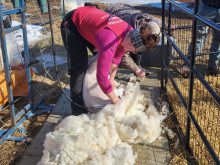SAN ANTONIO, Texas — The first shy hellos were exchanged last week between the world’s biggest chicken man and the world’s most ambitious beef producers.
John Tyson, president of Tyson’s Foods, ventured to the National Cattlemen’s Beef Association convention in San Antonio to pay his respects and learn what makes the fiercely independent beef industry tick.
He’s promising better food marketing that is focused on what customers want.
He adamantly shakes his head “no” to the most frequently asked question about the Tyson purchase of IBP.
Read Also

Charges laid after cattle theft
Saskatchewan RCMP lay two charges against a man after six cattle went missing.
“There will be no vertical integration. We’re just trying to sell a little more product the way the customer wants it. We’ve got 20 years of experience taking apart an animal,” he told reporters gathered at the convention held Feb. 1-4.
Tyson’s Foods has established a global chicken business that operates like a company-owned mining town.
Growers are contracted to produce chicken. The contract stipulates that they buy all feed, supplements and other supplies from Tyson-owned companies. They sell finished birds to company-owned processors and all products are sold under the Tyson brand name.
Tyson said the company’s basic plan is to create brand recognition for IBP products.
The world’s largest beef and pork packer, IBP tends to offer a generic product that consumers don’t notice at the fresh meat counter.
“Brand recognition is an important issue,” said John Lee, Tyson’s chief marketing officer.
“You have to think like a branded company. It is more than putting a name on a package. We will use our experience to see if we can cross over more quickly to a brand name.”
Marrying the two meat-producing giants makes sense to Tyson.
IBP has changed its operations substantially and is poised for the next phase of value-added food processing. It has already introduced the Thomas E. Wilson brand that offers precooked, heat-and-serve pot roasts. It also provides case-ready, portion-controlled meat to Wal-Mart’s super centres, which are combination grocery and department stores.
“If IBP looked like it did five years ago, I wouldn’t be in this room,” Tyson said.
He also said IBP will be a wholly owned subsidiary of Tyson’s, keeping its name and staff. No changes are planned for plants in America or for Lakeside IBP at Brooks, Alta.
In fact, IBP may acquire or build more plants as the business grows.
Tyson said he does not intend to push chicken over beef.
“I didn’t spend $4.5 billion not to sell beef.”
The company will get out of hog production, and plans to sell a 12,000-sow operation in North Carolina next week.
“We’re not as good at producing hogs as some others.”
Tyson’s sold its hogs to IBP and Cargill plants on contract.
How the company procures cattle in the future remains a concern.
If Tyson’s produces ready-to-eat, consistent products in the fresh and frozen departments, it is expected that only certain types of cattle will be bought through contract arrangements
Tyson said he is not familiar with cattle marketing grids, formulas or contracts. These systems call for certain carcass specifications for which the producer receives a premium price.
Instead, he said Tyson’s intends to bend to beef customer wishes because every part of the bird or animal has value to someone.
While chicken breast meat is a premium product, the popularity of buffalo wings has added value to a product that was worth less than five cents a pound 10 years ago. Wings now sell for 85 cents a pound.
Chicken feet were once sold for two cents a pound to pet food companies. A new market in China takes three million lb. per week for anywhere from 30 to 50 cents a pound.
“We sell them small, medium or large with the cuticle on or cuticle off,” Tyson said.
Punctuating his conversation with his favorite expression, “go forth,” he believes beef is ready for this kind of innovative product and marketing development.
IBP executives seemed overwhelmed by Tyson’s exuberance, but also said they are willing to grow with the chicken man to push new protein products.
“The food fight is over,” said IBP’s John Lehman, CEO of the fresh meat division.
“The emphasis has to be to enhance food safety.”

















